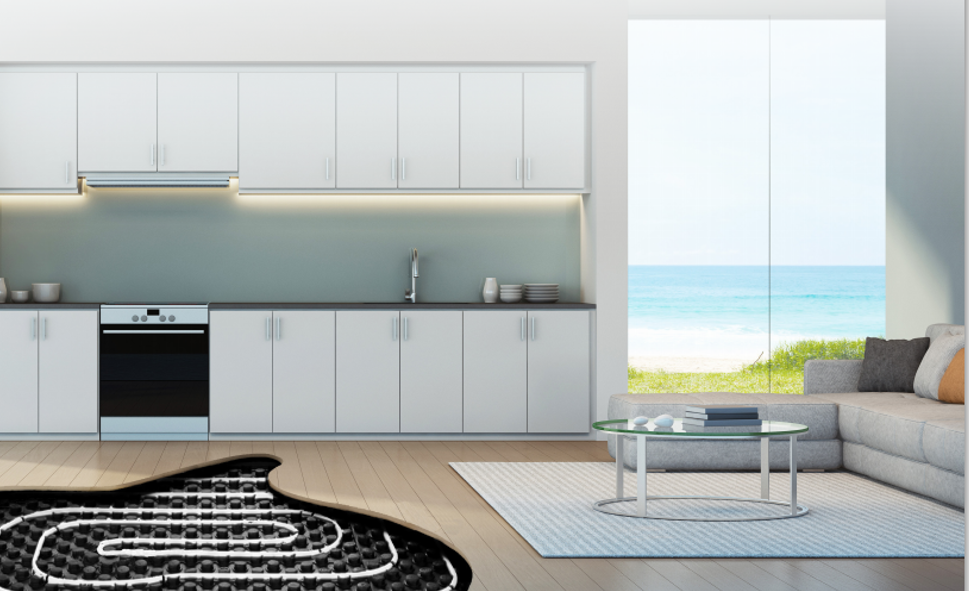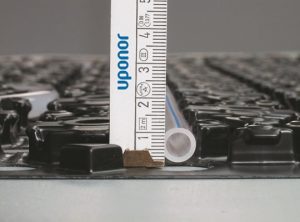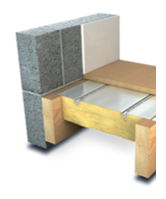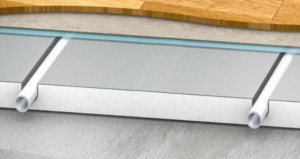
Heat Pump Heating and Cooling
Underfloor heating and cooling on suspended floors can be achieved with a heat pump. Hydronic heat pumps provide cooling when they operate in reverse cycle. You can circulate cool water underfloor for area cooling. However, cooling will be more effective with chilled water through fan-coil convectors in summer: more information.
Underfloor Heating
Underfloor heating is more expensive than radiator panels. Therefore, consider a combination of underfloor heating and radiator panels for heating and maybe fan coil convectors for heating and cooling. For example, it may make sense to have underfloor heating in your kitchen, dining and living rooms with radiator panels in your bedrooms.
Fan-coil convectors can be attached to your hydronic system or it may be better to add fan-coil convectors with an additional reverse cycle air conditioning system.
Also, consider hydronic towel rails in bathrooms. This is more important if you don’t have underfloor heating. If you do, then electric element towel rails may suffice as a less costly solution for drying your towels in winter and summer.
Underfloor Cooling
For underfloor cooling, install a thermostat with a humidity sensor to ensure your floor stays above the dew point. A floor temperature of around 18 degrees in summer is about right. This will maintain your floor above the dew point. Also, 18 degrees is pleasant to walk on with bare feet and sufficient to effectively absorb heat and transfer that outside.
Underfloor cooling works best in dryer southern or inland Australian climates. For the most effective underfloor hydronic cooling, install ceiling fans to circulate air across the floor. You will feel 3 to 4 degrees cooler as soon as you turn the fan on.
Floor Coverings
You can apply most types of floor coverings over your underfloor heating circuits although a decorative finishing screed or tiles are best.
Engineered timber boards are also quite acceptable. Most suppliers such as Havwoods will be happy to provide their normal flooring warranty over hydronic circuits. Check with them.
Vinyl and open weave carpet can also be used if their thermal resistance is less than 0.15 m²K/W for effective heating and 0.09 m²K/W for effective cooling. Thermal resistance of floor coverings higher than this will make your underfloor heating and cooling system less responsive and less effective.
Installation Methods
Hydrosol recommends these three installation methods for underfloor hydronic circuits on suspended floors:
- Minitec circuits, which will raise the floor level by 15mm minimum. Minitec is finished with a self levelling screed ready to take your finished flooring.
- Aluminium diffusion plates, which will raise your floor level by less than 1mm. They are fixed between your floor joists with insulation underneath.
- Expanded polystyrene panels (EPS), which will raise your floor by 30mm. EPS is lightweight, insulates and has very high compressive strength.
1. Minitec underfloor heating and cooling
Minitec can be laid directly onto your suspended timber or concrete floors. This thin capillary hydronic system will raise your floor by just 15mm minimum. The pipes have a diameter of just 9.9mm with 1.1 mm wall thickness. They are laid close together with spacing of 100mm. Single flow and return pipe circuits can run up to 60m.
Feel the heat from Minitec in about 20 minutes.

For large floor areas, consider the larger version of Minitec, diffusion plates or the EPS system, all designed for 16mm PEX pipe circuits. However, large Minitec will raise your floor level by 30mm. It will allow your circuit spacing to be 200mm with single flow and return pipe circuits up to 100m long. Therefore, it will be less expensive.
Installation process:
- Glue the base board onto your floor to give a secure bond for floor finishes.
- Press the thin PEX-A pipes into the base board.
- Gather the flow and return pipe ends inside a cabinet or service room for connection to a manifold.
- Pour a self-levelling fluid screed over the circuits. The screed can have decorative additives if used as the finished floor.
- Otherwise, apply floor finishes over the screed once it has set, such as tiles or engineered hardwood boards.
2. Aluminium diffusion plates
Aluminium diffusion plates are fixed between floor joists with insulation batts underneath. This minimises heat loss underneath and directs the heat through the floor.
Aluminium is highly conductive. Therefore, they conduct heat quickly and evenly underneath the floor.
Lay structural flooring directly over the diffusion plates. Make sure there is contact between the plates and the flooring. Diffusion plates are designed for 16mm PEX pipe with floor joists set at 400 mm centres.

Installation process:
- Push insulation batts between the joists with a snug fit.
- Fit batons to the joists to hold diffusion plates firmly underneath the flooring for good connection and conductivity.
- Press PEX pipe circuits into the grooves of the diffusion plates.
- Gather the flow and return pipe ends inside a cabinet or service room for connection to a manifold.
- The structural flooring is laid over the diffusion plates and fixed to the floor joists.
Expanded polystyrene panels
A third method involves expanded polystyrene panels (EPS) such as Uponor Siccus FX.
Consider this method if you you have good head height and need a light, insulated solution. It could be considered where the floor structure is variable, such as part suspended timber and part slab. Despite being lightweight, it has high compressive strength.
Expanded polystyrene panels are 30mm thick. Pre-formed grooves in the panels are designed to fit 16mm PEX circuits snugly underneath your finished floor surface. The aluminium face conducts heat from the hydronic circuits evenly through the floor surface. Lay cement sheets over the panels then apply your floor finishes. For greater thermal mass, increase the thickness of the cement sheets.

Expanded polystyrene panel
Installation process:
- Lay the expanded polystyrene panels onto your floor.
- Press the PEX pipe into the grooves of the panels.
- Gather the flow and return pipe ends inside a cabinet or service room for connection to a manifold.
- Lay thin cement sheets over the panels and PEX pipe.
- Mark the pipe location underneath.
- Fix the cement sheets to your suspended floor.
- Apply floor finishes onto the cement sheets.
